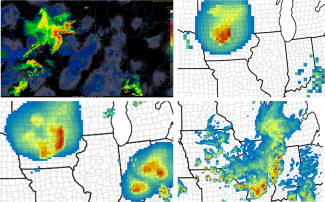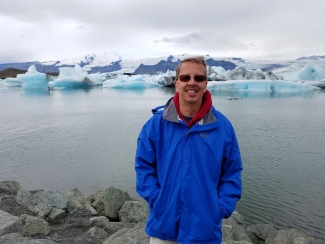The DTC Visitor Program offers a unique means of gaining experience with state-of-the-art modeling and visualization approaches. During my visits with the DTC through this program the previous three times, I explored these diverse areas of study, and was able to provide several graduate students with unique opportunities in these areas:
- the DTC's first convection-allowing model (CAM) ensembles run back in the mid-2000s,
- the Method for Object-based Diagnostic Evaluation (MODE) verification approach (which was new at that time), and
- the Community Leveraged Unified Ensemble (CLUE).
The new FV3-LAM model is a limited-area version of the nonhydrostatic Finite Volume Cubed Sphere dynamic core already running in the operational GFS model. This dynamic core is to replace most, or all, of the current models running operationally in the next few years, including those with convection-allowing grid spacing. Because my research has long focused on improved understanding and forecasting of convective- system evolution, I was invited to join an effort studying the impact of two different physics suites on several convective events. I am currently examining the output from my FV3-LAM runs using 3-, 13-, and 25- km horizontal grid spacing with physics packages closely matching the Rapid Refresh Forecast System (RRFS) and Global Forecast System (GFS), for three cases. The first case occurred in the northern Plains in May 2015, which was poorly predicted in my previous WRF runs. A second case that occurred in Texas during May 2019 was generally predicted well by CAM models. The third case, the infamous Midwestern Derecho of August 2020 that was the costliest single thunderstorm event in U.S. history, was poorly predicted by most CAMs, although some of the High Resolution Rapid Refresh (HRRR) and experimental HRRR runs from the evening before captured the event surprisingly well. The goal of the project is to see how well the physics suites perform through a range of horizontal grid spacing.
One of the more interesting findings involves the derecho event. By accident, 13- and 25- km horizontal grid spacing runs were performed without using convective schemes, and these runs did a surprisingly good job of showing the derecho in Iowa around 18 UTC 10 August (see Figure). However, the 3- km run performed very poorly because too much convection developed the night before, eliminating nearly all of the Convective Available Potential Energy (CAPE) in Iowa when the actual event occurred. This result is surprising because the FV3-LAM run was driven by initial and lateral boundary conditions from the successful 00 UTC HRRR-experimental run that did not experience this problem. When convective schemes were turned on, the 13-km results did not change noticeably, but the 25-km results were much worse, suggesting the schemes were very active at 25 km but inactive at 13 km.
More quantitative comparisons will soon be performed using MET to obtain some traditional skill measures, and MODE to focus on the convective systems of interest. I also plan to implement FV3-LAM on the supercomputer at my own university, and will be using it to explore upscale convective growth and morphology evolution in my own research.
William Gallus is a professor of meteorology at Iowa State University, where he has been since 1995. His research focuses on improved understanding and forecasting of convective systems, particularly their rainfall and evolution, through the use of convection-allowing model simulations. He teaches courses on synoptic and mesoscale meteorology and has won several teaching awards at Iowa State. When he isn't studying thunderstorms and severe weather, he can be found tending his garden, playing piano, hiking, and chasing tornadoes.

